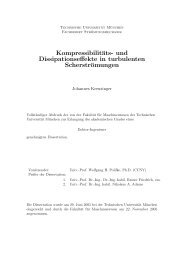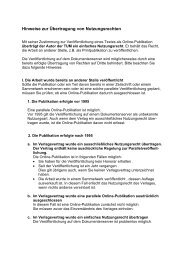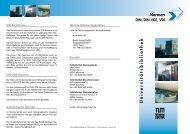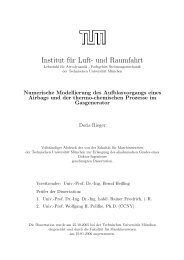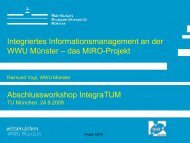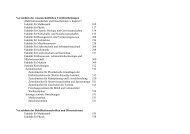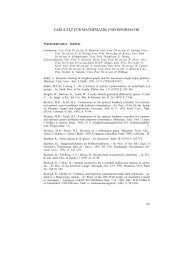LES of shock wave / turbulent boundary layer interaction
LES of shock wave / turbulent boundary layer interaction
LES of shock wave / turbulent boundary layer interaction
You also want an ePaper? Increase the reach of your titles
YUMPU automatically turns print PDFs into web optimized ePapers that Google loves.
eferred to as “higher-Reynolds-number experiment” (figure 1.4a). By<br />
matching directly the experimental parameters, the prediction quality<br />
<strong>of</strong> the employed sub-grid-scale model can be assessed without further<br />
assumptions. Given a successful validation, the computational results<br />
provide a reliable source for further analysis.<br />
While the reference experiment is done for the entire compressiondecompression<br />
ramp configuration, in the simulation we split this configuration<br />
into two parts, namely, the compression- and the decompressioncorner<br />
part. The reason for splitting the problem into two parts is<br />
tw<strong>of</strong>old. First, the estimated computational cost <strong>of</strong> well-resolved <strong>LES</strong><br />
for the full configuration is rather large and leads to rather long computational<br />
times. Second, the compression-corner <strong>interaction</strong> is sufficiently<br />
complex to justify a separate investigation. Preliminary compressioncorner<br />
results based on the analysis <strong>of</strong> limited statistical data were given<br />
by Loginov et al. (2004c, 2006b).<br />
In section 2 we provide the problem formulation and give a brief summary<br />
<strong>of</strong> the simulation method which is essentially the same as in Stolz<br />
et al. (2001a). A simulation for the <strong>turbulent</strong> <strong>boundary</strong> <strong>layer</strong> along a flat<br />
plate was used to provide inflow data for the compression ramp. Results<br />
for this precursor simulation are summarized in section 3. The main<br />
subject <strong>of</strong> this paper is the analysis <strong>of</strong> the compression-corner flow in<br />
section 4. A discussion <strong>of</strong> results <strong>of</strong> the successive decompression corner<br />
simulation is given in section 5. The last section 6 gives a summary and<br />
final conclusions.<br />
15



